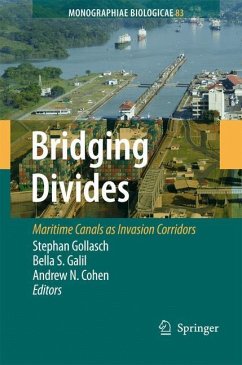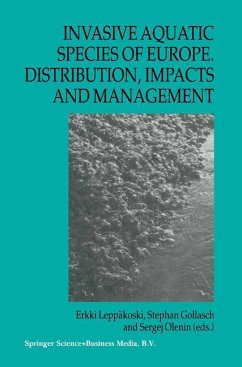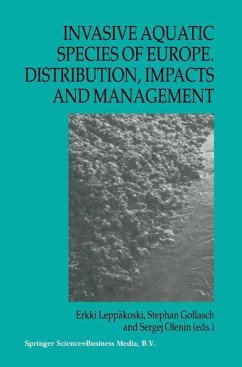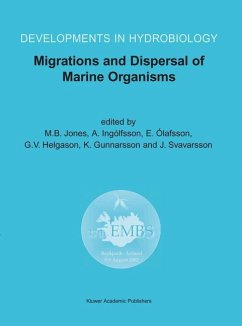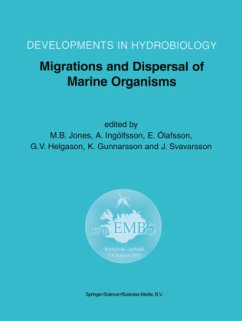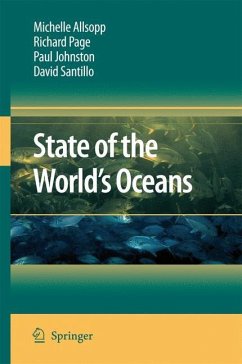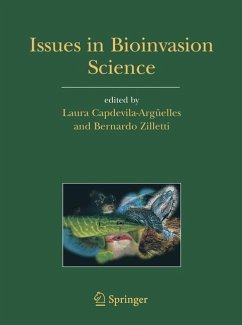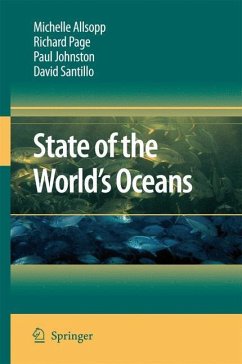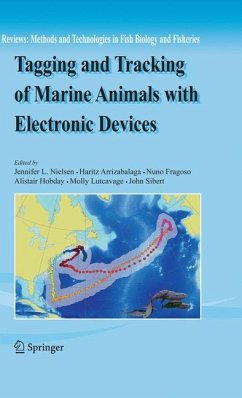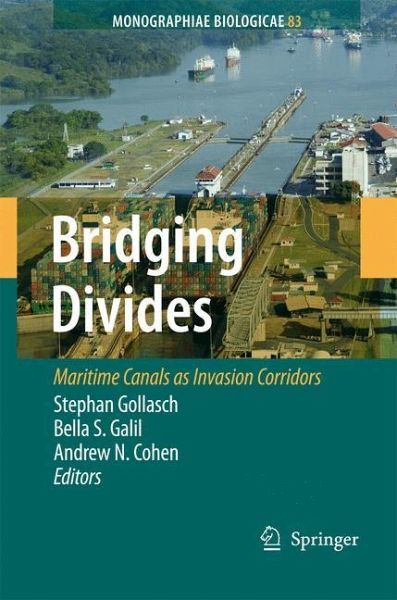
Bridging Divides
Maritime Canals as Invasion Corridors
Herausgegeben: Gollasch, Stephan; Galil, Bella S.; Cohen, Andrew N.

PAYBACK Punkte
57 °P sammeln!
Maritime canals dissolve natural barriers to the dispersal of marine organisms, thus providing novel opportunities for natural dispersal, as well as for shipping-mediated transport. The introduction of alien species has proved to be one of the most profound and damaging of anthropogenic deeds - with both ecological and economic costs.This book is the first to assess the impacts of the world's three principal maritime canals - the Kiel, the Panama, the Suez - as invasion corridors for alien biota. These three canals differ in their hydrological regimes, the types of biotas they connect, and in ...
Maritime canals dissolve natural barriers to the dispersal of marine organisms, thus providing novel opportunities for natural dispersal, as well as for shipping-mediated transport. The introduction of alien species has proved to be one of the most profound and damaging of anthropogenic deeds - with both ecological and economic costs.
This book is the first to assess the impacts of the world's three principal maritime canals - the Kiel, the Panama, the Suez - as invasion corridors for alien biota. These three canals differ in their hydrological regimes, the types of biotas they connect, and in their permeability to invasions.
Dr. Stephan Gollasch was involved in the first European ship sampling programme on ballast water, tank sediments and ship hull fouling (1992-1996). His PhD is world-wide the first thesis based on ballast water sampling. In addition to laboratory and desk studies he spent more than 125 days at sea during several biological surveys and joint ships on their voyages through the Kiel and Suez Canals. Due to the international aspect of biological invasions Dr. Gollasch became a member of several international working groups: International Council for the Exploration of the Sea (ICES); International Maritime Organization (IMO), and the Baltic Marine Biologists (BMB). As an independent consultant he is today involved projects related to biological invasions (e.g. ballast water treatment, ship sampling, risk assessment). Recently he was involved in the development of risk assessments and ballast water management scenarios for the European Atlantic coast, North, Baltic, Caspian and Mediterranean Seas.
Dr. Bella Galil is a Senior Research Scientist at the National Institute of Oceanography, Israel. Her main research interests are the anthropogenic changes occurring in the Levantine marine biota, and the impact of alien species on the Mediterraneanecosystem. She has conducted numerous studies and surveys off the Israeli coast monitoring the benthic biota from the intertidal to the bathyal. She co-chairs the scientific committee of marine ecosystems of the International Commission for Scientific Exploration of the Mediterranean (CIESM), and is a member of the Invasive Species Scientific Committee, IUCN. Galil published over 130 papers in scientific journals and co-edited a volume of the "CIESM Atlas of Exotic species in the Mediterranean". Recently she coordinated the drafting of Guidelines for controlling the vectors of introduction into the Mediterranean of non-indigenous species and invasive marine species for the UNEP Mediterranean Action Plan Regional Activity Centre for Specially Protected Areas RAC/SPA.
Dr. Andrew Cohen is the Director of the Biological Invasions Program at the San Francisco Estuary Institute in Oakland, California. His research has focused on the extent, impacts and vectors of aquatic invasions. He has organized and led rapid assessment surveys for exotic marine species in various localities including one at both ends of the Panama Canal. He helped write California's first ballast water law in 1999, and recently helped develop ballast water discharge standards for the state that seem likely to be enacted this year. He also drafted a petition from the research community that led to a U.S. ban on importing the "Killer Seaweed" Caulerpa taxifolia, and provided technical assistance to a recently successful lawsuit that will force ballast water discharges into U.S. waters to be regulated as biological pollutants under the U.S. Clean Water Act. For his work he has received a Pew Marine Conservation Fellowship and the San Francisco BayKeeper's Environmental Achievement Award.
This book is the first to assess the impacts of the world's three principal maritime canals - the Kiel, the Panama, the Suez - as invasion corridors for alien biota. These three canals differ in their hydrological regimes, the types of biotas they connect, and in their permeability to invasions.
Dr. Stephan Gollasch was involved in the first European ship sampling programme on ballast water, tank sediments and ship hull fouling (1992-1996). His PhD is world-wide the first thesis based on ballast water sampling. In addition to laboratory and desk studies he spent more than 125 days at sea during several biological surveys and joint ships on their voyages through the Kiel and Suez Canals. Due to the international aspect of biological invasions Dr. Gollasch became a member of several international working groups: International Council for the Exploration of the Sea (ICES); International Maritime Organization (IMO), and the Baltic Marine Biologists (BMB). As an independent consultant he is today involved projects related to biological invasions (e.g. ballast water treatment, ship sampling, risk assessment). Recently he was involved in the development of risk assessments and ballast water management scenarios for the European Atlantic coast, North, Baltic, Caspian and Mediterranean Seas.
Dr. Bella Galil is a Senior Research Scientist at the National Institute of Oceanography, Israel. Her main research interests are the anthropogenic changes occurring in the Levantine marine biota, and the impact of alien species on the Mediterraneanecosystem. She has conducted numerous studies and surveys off the Israeli coast monitoring the benthic biota from the intertidal to the bathyal. She co-chairs the scientific committee of marine ecosystems of the International Commission for Scientific Exploration of the Mediterranean (CIESM), and is a member of the Invasive Species Scientific Committee, IUCN. Galil published over 130 papers in scientific journals and co-edited a volume of the "CIESM Atlas of Exotic species in the Mediterranean". Recently she coordinated the drafting of Guidelines for controlling the vectors of introduction into the Mediterranean of non-indigenous species and invasive marine species for the UNEP Mediterranean Action Plan Regional Activity Centre for Specially Protected Areas RAC/SPA.
Dr. Andrew Cohen is the Director of the Biological Invasions Program at the San Francisco Estuary Institute in Oakland, California. His research has focused on the extent, impacts and vectors of aquatic invasions. He has organized and led rapid assessment surveys for exotic marine species in various localities including one at both ends of the Panama Canal. He helped write California's first ballast water law in 1999, and recently helped develop ballast water discharge standards for the state that seem likely to be enacted this year. He also drafted a petition from the research community that led to a U.S. ban on importing the "Killer Seaweed" Caulerpa taxifolia, and provided technical assistance to a recently successful lawsuit that will force ballast water discharges into U.S. waters to be regulated as biological pollutants under the U.S. Clean Water Act. For his work he has received a Pew Marine Conservation Fellowship and the San Francisco BayKeeper's Environmental Achievement Award.





